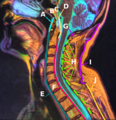Nuchal ligament
| Nuchal ligament | |
|---|---|
 Muscles connecting the arm to the spine seen from behind (nuchal ligament labeled in red at center) | |
 | |
| Details | |
| System | skeletal |
| From | external occipital protuberance |
| To | spinous process of cervical vertebra 7 |
| Identifiers | |
| Latin | Ligamentum nuchae |
| TA98 | A03.2.01.006 |
| TA2 | 1678 |
| FMA | 13427 |
| Anatomical terminology | |
The nuchal ligament is a ligament at the back of the neck that is continuous with the supraspinous ligament.
Structure[]
The nuchal ligament extends from the external occipital protuberance on the skull and median nuchal line to the spinous process of the seventh cervical vertebra in the lower part of the neck.[1]
From the anterior border of the nuchal ligament, a fibrous lamina is given off. This is attached to the posterior tubercle of the atlas, and to the spinous processes of the cervical vertebrae, and forms a septum between the muscles on either side of the neck.
The trapezius and splenius capitis muscle attach to the nuchal ligament.
Function[]
It is a tendon-like structure that has developed independently in humans and other animals well adapted for running.[2] In some four-legged animals, particularly ungulates, the nuchal ligament serves to sustain the weight of the head.
Clinical significance[]
In Chiari malformation treatment, decompression and duraplasty with a harvested nuchal ligament showed similar outcomes to pericranial and artificial grafts.[3]
Other animals[]
In sheep and cattle it is known as the paddywhack.[dubious ] It relieves the animal of the weight of its head. Dried paddywhack is commonly packaged and sold as a dog treat.[citation needed]
In most other mammals, including the great apes, the nuchal ligament is absent or present only as a thin fascia.[2] As it is required for running, not all animals have one.[4]
All dogs (and all living Canidae - wolves, foxes, and wild dogs) possess a similar ligament connecting the spinous process of their first thoracic (or chest) vertebrae to the back of the axis bone (second cervical or neck bone), which supports the weight of the head without active muscle exertion, thus saving energy.[5] This ligament is analogous in function (but different in exact structural detail) to the nuchal ligament found in ungulates.[5] This ligament allows dogs to carry their heads while running long distances, such as while following scent trails with their nose to the ground, without expending much energy.[5]
In horses, the parasite Culicoides can spread onchocerca cervicalis by living in the nuchal ligament, causing dermatitis.[6]
Additional images[]

I: Nuchal ligament

Occipital bone seen from outside (nuchal lines are identified at left)
See also[]
References[]
![]() This article incorporates text in the public domain from page 290 of the 20th edition of Gray's Anatomy (1918)
This article incorporates text in the public domain from page 290 of the 20th edition of Gray's Anatomy (1918)
- ^ Drake, Richard L.; Vogl, Wayne; Tibbitts, Adam W.M. Mitchell; illustrations by Richard; Richardson, Paul (2005). Gray's anatomy for students (Pbk. ed.). Philadelphia: Elsevier/Churchill Livingstone. p. 45. ISBN 978-0-443-06612-2.
- ^ Jump up to: a b Swindler, D. R., and C. D. Wood. 1973 An Atlas of Primate Gross Anatomy. Seattle: University of Washington Press[page needed]
- ^ Cools MJ, Quinsey CS, Elton SW (April 2018). "Chiari decompression outcomes using ligamentum nuchae harvest and duraplasty in pediatric patients with Chiari malformation type I". J Neurosurg Pediatr. 22 (1): 47–51. doi:10.3171/2018.1.PEDS17670. PMID 29652242.
- ^ Bramble, Dennis M.; Lieberman, Daniel E. (2004). "Endurance running and the evolution of Homo". Nature. 432 (7015): 345–52. Bibcode:2004Natur.432..345B. doi:10.1038/nature03052. PMID 15549097. S2CID 2470602.
- ^ Jump up to: a b c Wang, Xiaoming and Tedford, Richard H. Dogs: Their Fossil Relatives and Evolutionary History. New York: Columbia University Press, 2008. pp.97-8
- ^ Haussler, Kevin K.; Jeffcott, Leo B. (2014). "21 - Back and pelvis". Equine sports medicine and surgery : basic and clinical sciences of the equine athlete (2nd ed.). Edinburgh: Saunders. pp. 419–456. doi:10.1016/B978-0-7020-4771-8.00021-1. ISBN 978-0-7020-4771-8. OCLC 865010322.
External links[]
- Wikipedia articles incorporating text from the 20th edition of Gray's Anatomy (1918)
- Bones of the vertebral column
- Ligaments
- Ligaments of the head and neck

